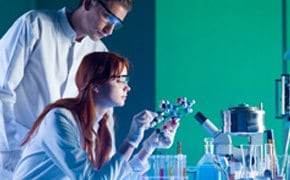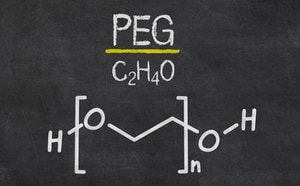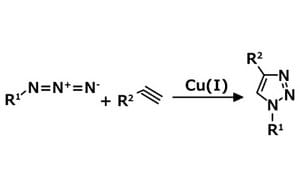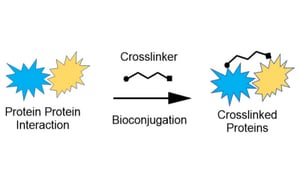ADC & Bioconjugation

Bioconjugation involves ligating molecules together in which at least one of the reactants is a biomolecule, often an antibody, protein, or oligonucleotide. Bioconjugates are used for detection, assay, or targeting and tracking of biomolecules in the fields of biotechnology, medicine, and nanotechnology. Applications include attaching fluorescent probes to antibodies for flow cytometry and microscopy imaging, attaching antibodies to beads for immunoprecipitations, attaching antibodies to drugs for therapeutic development, and crosslinking of proteins to detect their biological interactions.
Antibody-drug conjugation (ADC) technology uses monoclonal antibodies to deliver highly active or potent pharmaceutical ingredients (HPAPIs) to targeted cells. In conjugated form, the HPAPIs exhibits more selective therapeutic activity, sparing non-target cells. This bioconjugation technique is utilized for targeted and safer drug delivery. The chemical and physical properties, length, molecular size, water miscibility, and cleavability of the reagent, the application criteria and the functional groups targeted for coupling determine which crosslinking reagents and reaction method are chosen for optimal bioconjugation.
Featured Categories
Discover our selection of polyethylene glycol (PEGs) and PEG derivatives in a wide range...
High-quality amino acids, resins, and reagents including Novabiochem® for peptide....
Click chemistry reagents accelerate progress in chemical biology, bioconjugation, and...
Linkers and crosslinkers offer structural stability in bioconjugation for protein-protein, protein-peptide, and peptide-small molecule interactions.
Bioconjugation Crosslinker Types
One of the most fundamental aspects of crosslinker design is whether the reagent is homobifunctional or heterobifunctional. The overwhelming majority of bioconjugate reagents are bifunctional, with two reactive groups usually located at the outer ends of an organic spacer. In a homobifunctional compound, the two reactive groups are identical, whereas in a heterobifunctional compound they are different. Heterobifunctional reagents have major advantages over homobifunctional ones when forming bioconjugates, since one reactive end group couples with only a specific functional group, while the other reactive end group reacts with a different functional group.
Bioconjugation Crosslinker Length
The dimensions or overall linear length of the target molecule before and after conjugation should be considered when choosing a crosslinker or modification reagent for the conjugation reaction. The spacer arm or cross-bridge of the reagent mainly determines the molecular length of the resulting compound. Crosslinkers of different sizes thus become molecular rulers for measuring the distances between functional groups in biomolecules.
Cleavable vs Non-cleavable Bioconjugation Crosslinkers
It is important for the crosslinker to be cleavable if the interacting biomolecules need to be isolated and analyzed, e.g. a crosslinker used to detect protein-protein interactions. Alternatively, a non-cleavable linker could be used where stability is required, e.g. an antibody attached to a resin for protein capture.
Hydrophobic vs Hydrophilic Bioconjugation Crosslinkers
In some applications, reagent hydrophobicity can be an advantage, especially when an application involves the penetration of cell membranes. Hydrophobic reagents without any strongly polar groups quickly pass through cell membranes to crosslink or label internal cell proteins. On the other hand, hydrophilic crosslinkers do not cause aggregation or precipitation of the interacting molecule and can lead to water solubility of antibodies and proteins modified by them. The use of hydrophilic bioconjugation reagents also results in greater biocompatibility.
Functional Groups Targeted in Bioconjugation
The most reactive functional groups in biomolecules are associated with the heteroatoms N, O, and S, which are nucleophilic due to an unshared pair of electrons and can spontaneously react with the compatible and electrophilic active groups on crosslinkers and modification reagents. In many cases, the nucleophilic functional groups in biomolecules are free and accessible. However, in some instances they are created to allow reactivity and coupling to take place. There are several specialized reagents available that facilitate the creation of an appropriate functional group for bioconjugation if the desired one is not available. The naturally occurring functional groups on biomolecules are amines, thiols, hydroxyls, carboxylates, aldehydes, organic phosphates, and reactive hydrogens on certain activated carbon atoms.
ADC Development and Manufacturing
The development journey of an antibody-drug conjugate (ADC) requires expertise in small and large molecule development, manufacturing, formulation and testing. Choosing an experienced partner, with these skills and the required containment facilities can help advance your ADC to market. ADCs are challenging molecules requiring advanced manufacturing suites and dedicated equipment to characterize the molecule and demonstrate its purity, homogeneity, and stability.
Visit our document search for data sheets, certificates and technical documentation.
Related Articles
- Choosing the right crosslinker for your biochemical or bioconjugation research can be challenging. Our selection guide can help you find the perfect match for your applications.
- Click chemistry is an approach to the synthesis of drug-like molecules that can accelerate the drug discovery process by using a few practical and reliable reactions.
- Explore the principles and applications of click chemistry in drug discovery, highlighting efficient reactions that streamline the synthesis of bioactive compounds.
- Copper-free click chemistry is an alternative approach to click chemistry that proceeds at a lower activation barrier and is free of cytotoxic transition metal catalysts.
- The Staudinger Ligation: A High-Yield, Chemoselective, and Mild Synthetic Method.
- See All (12)
Find More Articles and Protocols
How Can We Help
In case of any questions, please submit a customer support request
or talk to our customer service team:
Email custserv@sial.com
or call +1 (800) 244-1173
Additional Support
- Chromatogram Search
Use the Chromatogram Search to identify unknown compounds in your sample.
- Calculators & Apps
Web Toolbox - science research tools and resources for analytical chemistry, life science, chemical synthesis and materials science.
- Customer Support Request
Customer support including help with orders, products, accounts, and website technical issues.
- FAQ
Explore our Frequently Asked Questions for answers to commonly asked questions about our products and services.
To continue reading please sign in or create an account.
Don't Have An Account?



